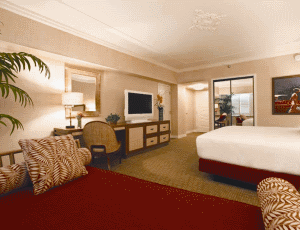Longtime Las Vegas Architect Joel Bergman recalls when the leaded glass ceiling debuted inside the Tropicana over 30 years ago. “Nothing like that had been done before inside a casino. It changed the texture of design in Las Vegas,” he says.

Bergman would know. He spent 16 years as Steve Wynn’s in-house architect, helping create The Mirage, Treasure Island and Golden Nugget, before founding Bergman Walls & Associates in 1994.
The Tropicana’s $1 million, 4,000-sq-ft Art Nouveau-style glass ceiling, which was designed by architect Tony DeVroude, spans the casino’s main blackjack area. Bergman’s firm is returning it to its former glory as part of a $180-million makeover of the Tropicana — much of the money for fixtures and finishes. The 53-year-old hotel-casino on the south end of the Strip had gone virtually unchanged since its last renovation in 1986.
The renovation of hotel rooms, restaurants, the casino and convention center is being paid for by new owners. Former MGM Grand executive Alex Yemenidjian’s company, Armenco Holdings, Las Vegas, and Toronto-based private equity firm Onex Corp., purchased the historic resort from bankruptcy in July 2009. Those companies hired Mason Building Co. Inc., Las Vegas, as the general contractor on the project.
“The renovation makes a lot of sense,” says Grant Govertsen, principal and analyst with Union Gaming Group, Las Vegas. “The Tropicana certainly needed a facelift to help it remain competitive, especially since it is a single-asset property. This renovation should generate incremental revenue increase and improve cash flow.”
Prior to the renovation, in 2009, several travelers reported their experiences at the Tropicana on the website Tripadvisor.com and commented on the faded interiors. One posted a comment in defense, saying the old facilities were acceptable because the room cost only $50 a night, well below average. The Las Vegas Convention & Visitors Authority reports that for most of 2010, the average room rate in Las Vegas was about $95.
A Total Revamp
A spokesman for the Tropicana says the aim of the project is “the rapid creation of a South Beach-inspired theme that captures a tropical and sultry vibe.”
But everything can’t be done at once. Bergman Walls, along with interior designer Yates-Silverman Inc., are phasing the work to allow the hotel to remain in operation. Yates-Silverman Partner Charles Silverman says the idea was to use as much of the existing structure as possible.
Not all structures in the expansive resort, which is Y-shaped in plan, could be preserved and reused.
For example, the three-level, concrete and metal-framed Garden Rooms were imploded on Nov. 9 to make way for a new porte-cochere valet parking entrance. The demolished wing was the oldest part of the resort, dating back to 1957.
In addition to renovating the 50,000-sq-ft casino area and leaded stained glass ceiling, the 60,000-sq-ft convention center was enhanced and the four-acre pool deck was resurfaced.
Reconfigured Interior
The interior is being reconfigured for a more open and flowing environment that creates space for a new high-limit gaming area and restaurants.
Contractors also picked up a pedestrian bridge from ground level. The 6,000-sq-ft bridge connecting the 22-story Paradise Tower and 21-story Island Tower had been a “cacophony of little kiosks and mish-mash,” Bergman says. The link was elevated to the second level and revamped to create “a clean, broad esplanade,” Bergman adds.
As part of the renovation, contractors applied an exterior facade film to the Island Tower to reduce guest room heat gain. The film also gives the 24-year-old building a gleaming new white appearance without obstructing interior views.
Vertical transportation also got a makeover. Contractors modernized or replaced the property’s 18 elevators and five escalators. They remodeled a 4,000-sq-ft Legends Steak & Seafood, and it has been rebranded as Biscayne Steak, Sea & Wine.
The main entrance along Tropicana Avenue is getting a makeover, too: the street is being renamed Ocean Drive to reflect the resort’s revamped identity.
The Tropicana renovations come after the previous owners, Phoenix-based Aztar Corp. and then-Kentucky-based hotelier William Yung III, floated grandiose plans of completely overhauling the Tropicana or even imploding the building to construct a new 10,000-room resort, but the companies ended up filing for Chapter 11 bankruptcy. With none of the capital spending materializing, the Tropicana’s revenues fell 27.7% between 2005 and 2008; the resort began operating at a loss in 2007.
New Chapter
The Tropicana’s transformation has taken place in stages, with construction beginning in early 2009 and the project’s first phase nearing completion in December 2010.
This is the last big construction project on the Las Vegas Strip for the foreseeable future. But that could be a good thing: The city’s hotel-casino market was overbuilt and needs to absorb its existing capacity.
Now the Tropicana’s in a position to profit as the economy recovers, occupancies head up and room rates follow. There shouldn’t be many, if any, $50-a-night stays at the old hotel any longer.
Article toolbar


Post a comment to this article
Report Abusive Comment